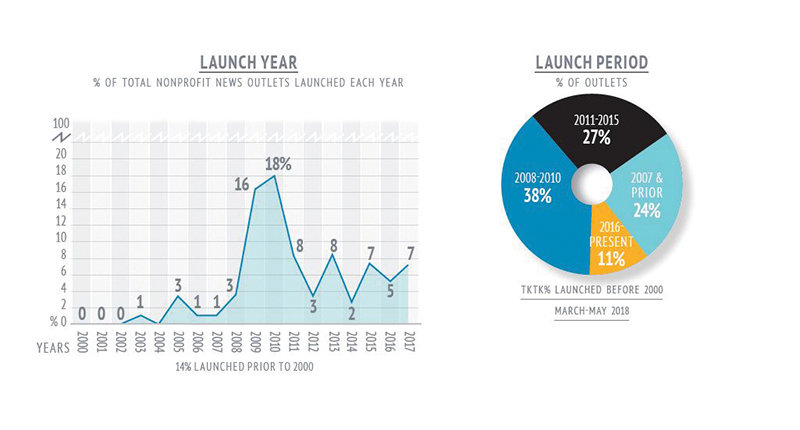
When the Philadelphia Inquirer was donated to a nonprofit organization two years ago, most readers probably didn’t noticed the sweeping changes that went on behind the scenes, like appointing a new board comprised of leading journalism school deans and foundation executives, or the $20 million endowment that was set up for the then-new project. What they did start to see, however, was an emphasis on more and better investigative reporting in the sixth largest city in the country.
And here’s how it worked: Owner H.F. “Gerry” Lenfest essentially gifted the Inquirer along with the Philadelphia Daily News and Philly.com to the Philadelphia Foundation, or more specifically to the Institute for Journalism in New Media (later renamed the Lenfest Institute for Journalism). The Philadelphia Media Network (PMN), as the company is now known, has since become the beneficiary of key philanthropic donations that have been funding missing critical local journalism.
The move made a lot of headlines in and outside the industry, and for good reason. It was the first time since the 1970s that a major city daily made such a move. And while PMN remains today a self-governing company beholden to its own journalistic merits, the transition has, in part, eased at least some of the financial pains that had previously led to headline-making slashes to operations and talent.
Whether more papers will follow suit is a big question, one that’s certainly been on the minds of researchers at Nieman Lab who asked two years ago: “If newspapers are having trouble turning a profit without deep annual cuts, how about becoming a nonprofit?”
An even bigger question might be: Could nonprofit journalism actually help save news? It’s a question that’s been echoing through countless newsrooms across the country as media struggles to contend with declining print advertising and subscriptions in the digital age. And if the root of the problem is being able to generate adequate revenue (which is down almost half from a mere decade ago), it makes sense that media companies of all stripes and sizes might want to look more closely at the nonprofit news model as a blueprint for operating, well, a little differently.
Bigger Revenue
According to this year’s Institute for Nonprofit News “INN Index: The State of Nonprofit News,” which was published in early October, there are many quantifiable benefits of nonprofit news, most notably the ability for editorial to focus on original reporting with deep coverage into key civic issues.
In fact, 40 percent of the nonprofit news organizations surveyed defined themselves as being “primarily investigative.” One in four, says INN, regard their mission as “analysis and explanatory journalism.”
These days, most nonprofit media organizations tend to be focused on topics somehow involving and/or impacting the public interest. “Single-subject news is one of the fastest-growing categories in nonprofit media,” according to the report. “A third of news nonprofits focus on a single subject such as health, education, environment or justice.”
The editorial choices are having an impact on the bottom line, said Sue Cross, executive director and CEO of INN. More than half of the nonprofits surveyed generated $500,000 or more in revenue in 2017 (and a third made $1 million or more).
 Sue Cross
Sue Cross
“The nonprofit field is still highly reliant on charitable giving,” said Cross, “with grants and donations accounting for 90 percent of total revenue.”
The report also shows that as more nonprofits dig deep into investigative news, readers are taking notice and opening their wallets. INN is seeing higher growth from individual donors, finding that readers are actually more willing to make donations than to subscribe in the current culture. And though most nonprofit news organizations are typically young, about eight years old on average, they represent almost $350 million in overall revenue growth.
“This improvement in revenue is much bigger than expected,” Cross said.
Funding nonprofit journalism has been and continues to be a practice in trial and error. But a few new revenue initiatives are finding a lot of success, like NewsMatch.org, a three-year-old grassroots campaign designed to specifically fund nonprofit news through matching funds. To date, NewsMatch has helped raise more than $5 million for organizations, and engaged tens of thousands of new donors. Some of the national partners include the Knight and Gates Foundations, Democracy Fund and News Revenue Hub.
“The economy of covering news is very challenging for everybody,” said Cross. “But nonprofits do have some advantages. The truth is that consumer patterns—where people go for news and where they find it, and even deciding what they believe and don’t believe—are challenging and changing rapidly.”
She said another advantage is being fundamentally mission based. “They belong to the public and so they are transparent. They are really homegrown.”
 Graphic provided by the Institute for Nonprofit News
Graphic provided by the Institute for Nonprofit News
Choosing Their Targets
At the MinnPost, a nonprofit, nonpartisan news organization based in Minneapolis, Minn., editor Andrew Putz said there are plenty of advantages for operating nonprofit right now.
“For us, it’s the fact that we are not trying to be everything to all people,” he said. “We’re not trying to be a digital version of a metro newspaper, so we’re able to pick and choose our targets. That is liberating, even if being disciplined about what we do (and don’t) cover isn’t always easy.”
The goal at MinnPost has always been to create a sustainable business model that’s supported by corporate sponsors, advertisers and people from the community. As such, Putz said there tends to be a lot of flexibility to pursue stories that are important, which might explain why MinnPost has been able to attract top talent from the Twin Cities media world.
 Andrew Putz
Andrew Putz
“For journalists, I think sometimes the hardest thing is to say ‘no’ to a story; to not pursue something people are talking about,” Putz said. “But we would rather do three really good stories that are core to our mission than 10 pieces about stuff that everybody else is doing.”
MinnPost also doesn’t endorse candidates or publish unsigned op-eds as is the norm for most other dailies. Instead, there is much more of an emphasis on community commentary and feedback that parallels, interestingly, to a lot of discourse on social media. Otherwise the editorial goals at MinnPost aren’t so different from the competition—delivering thoughtful and timely reporting that matters.
“I think we’re different,” said Putz, “in that our focus isn’t about trying to be incrementalist. We like to break news, of course, but our goal isn’t to have the latest tidbit five minutes before somebody else. Our focus—our obsession, really—is with trying to explain and contextualize the critical issues facing the state.”
Investigative journalism has become a big part of what MinnPost and other nonprofits are focused on, especially as for-profit journalism sees cutbacks to this vital area of reportage. Ask any editor or reporter and they will likely tell you that this serious, in-depth reporting is exactly the sort of work that sustains democracy in both the short and long term, particularly when the media comes under fire almost daily from the White House.
Putz admits that he’s seen the results of solid investigative work impact the community for the better, and that readers are taking notice and paying to access the news they trust, news that’s essentially about them and where they live and work.
For example, when MinnPost staff writer Sam Brodey discovered that one of the state’s best-known politicians, Rep. Rick Nolan, allowed a former top legislative staffer to quietly resign after being accused of sexual harassment (and then rehired the staffer to work on his congressional campaign), he exposed it.
“It was important,” said Putz, “because Nolan had recently agreed to be a lieutenant governor candidate on the gubernatorial ticket.”
 Graphic provided by the Institute for Nonprofit News
Graphic provided by the Institute for Nonprofit News
Covering All the News
Nonprofit news is hardly a new phenomenon. In 1936, the owner of the British newspaper the Guardian transferred his shares into a trust that’s still in operation today (in fact, it helped launch the Guardian’s American news site). Similarly, as the oldest and largest nonpartisan, nonprofit investigative news organization, the Center for Public Integrity in Washington D.C. actually got its start on this side of the pond in 1989. Over the years, the Center has had a hand in exposing stories related to everything from politics and national security to business, workers’ rights and, most recently, immigration.
“We’re supported primarily by large foundations, which has proven to be a good model given that we’re entering our thirtieth year of existence,” said John Dunbar, the Center’s outgoing CEO.
Despite the successes, he is worried about the sustainability of this business model. “We’re actively seeking ways to diversity revenue through membership programs, individual donors and earned revenue,” he said.
Just like for-profits, nonprofits have the inevitable financial debates, too, about not only where funding will come from, but how it should ultimately be allocated. But among nonprofits, clicks tend to be less important than content. Most of them see themselves as delivering the news that needs to be reported, even if it doesn’t go viral, which it often doesn’t. That being said, diverse communities of readers tend to respond favorably to this new old-style approach.
 John Dunbar
John Dunbar
“The greatest advantage for us is time,” Dunbar said. “We’re not slaves to the news cycle and can focus on our investigations. Since we’re able to devote more effort into the reporting, the stories have a greater impact than daily coverage. In fact, we expect it. I think it adds a dimension to the news landscape to have investigative specialists from nonprofits. We’re covering things most news outlets are not.”
Some of the most recent headlines, for example, take a hard look into dangers at immigrant detention centers, the impact of the latest FCC reforms on cell phone consumers and why wind energy is losing federal support.
The Center and its reporters have won several Pulitzers over the years, but as most papers know, industry accolades don’t guarantee profitability.
“Probably the biggest challenge we face these days is competition for funding from new nonprofit entities entering the market,” Dunbar said. “We’ve also had a historic problem when it comes to our brand and name recognition, something we’re addressing now with a new communications plan. It’s tough to stand out among all the media players today.”
There’s also the question of competition, namely how much or little nonprofits compete with for-profit news organizations. Dunbar said the answer is pretty simple: “We try hard not to compete. We would much rather collaborate. I don’t want to duplicate efforts; it’s just not efficient. Collaborations are often challenging, but also rewarding.”
Overcoming Challenges
When it launched in 2005, the Voice of San Diego was the country’s first-ever digital nonprofit news organization to serve a local community. Over the years, the online publication has distinguished itself with plenty of hard-hitting investigations into subjects ranging from politics to sexual misconduct in public schools, and provided readers a platform to discuss issues that impact their daily lives.
Besides being a pioneer in both nonprofit and digital media, the Voice also does something a little different from its competitors—it shares its staff-produced content with community organizations and even other publications. As a result, it has built a sustainable business model that relies on sponsors, investment from foundations and support from individuals. The collaboration has also helped build name recognition over the years.
Scott Lewis, the Voice’s editor and CEO, says the organization is nothing if not mission driven. The nonprofit structure actually encourages best practices.
“Nonprofit organizations are not shareholder owned,” Lewis said. “They’re guided by a board of directors, management of the staff and a mission that they all share. For-profit companies have a mission to deliver shareholder profits and value. I love the free market and think that this has created some wonderful benefits for society. However, in the news business, the nonprofit structure certainly means that you have to justify your approach—what you cover, why and how deeply—based on your mission and how much it matters.”
 Scott Lewis
Scott Lewis
At the Voice, the mission is pretty straightforward: To consistently deliver groundbreaking investigative journalism for the San Diego region, and to increase civic participation by giving residents the knowledge and in-depth analysis necessary to become advocates for good government and social progress. The Voice has positioned itself as not just a news outlet, but also an advocate for the community.
A few years ago, the Voice took this idea a step further with its “What we stand for” credo that was designed to help the board and staff “never veer off course,” or to chase revenue over the core mission. In that statement, the Voice makes several pleas related to government transparency and accountability, participation in civic affair, an inclusive arts scene and healthy ecosystem.
“I don’t think any other news organization has a similar document,” Lewis said. “I think they all should. Being a nonprofit is not necessarily an advantage, but it’s a way of making sure we’re on track and not chasing things just for profit.”
But doing the kind of investigative stories that can inform and realistically enact change can be both timely and costly to non-and for-profit media alike, which is why many nonprofits are seeking to diversify their revenue streams in much bigger ways.
“We have major donors, grants from foundations, major sponsors, members and media partners that each provide funding,” Lewis said. “The goal is to not only create more of those sources of funding but to diversify within them—more donors, more members, more sponsors.”
Currently, the Voice has about 2,600 individual donors, the folks Lewis calls “the backbone of our sustainability.” The biggest challenge, however, is to reach an audience large enough to build an even more diversified base of financial support that can ultimately serve a diverse community.
“If you don’t launch with a lot of capital, then you can get stuck in a dilemma,” Lewis said. “You need to cover a lot of things to make sure that you are relevant to a lot of people, but you can’t cover a lot of things without some money and thus you can’t get money unless you cover a lot of things.”
It’s a Catch-22 that most newspapers are or have been caught up in, especially in the increasingly competitive 24/7 news cycle. News organizations that want to make sure a large metropolitan area like San Diego is properly covered with investigative and public accountability reporting, said Lewis, “need to launch with enough startup funds to make sure they can do a good, diverse job at first. Otherwise it can be a long slog, like what we have had to undertake over the last 13 years.”
Lewis said it hasn’t always been easy, but that the number don’t lie. Supporting nonprofit media is within reach if people want it bad enough, he said, and San Diego could conceivably have an investigative journalist in every major “mega-neighborhood” (there are about 60 in the region) for about $8 million per year.
“That’s less than the operating cost of a major museum,” Lewis said.
What’s Next?
Nonprofit journalism, while still not the norm, is finding an important niche in far-reaching communities, from the largest cities to small towns, any place where audiences crave compelling and reliable news covering the issues that are most important to their own lives. Perhaps one of the most powerful aspects of nonprofit media really comes down to the people who are taking the chances and ultimately making it work.
INN’s report stated, “They deploy a substantial body of experienced, expert journalists at a time when other media are cutting back, and the nonprofits increasingly fill the gaps in public information. They are starting to diversify the revenue streams that support this important reporting.”
Will it be enough to sustain a news industry that continues to face some of the toughest challenges yet? No one can be sure. But one thing nonprofit news organizations do seem to remind us is that making real progress often means being willing to evolve, and not always in the direction we might expect. As technology and peoples’ expectations continue to shift, it’s likely the future of nonprofit will deliver some very surprising results.
Comments
No comments on this item Please log in to comment by clicking here